brake sensor TOYOTA YARIS CROSS 2022 Owner's Manual
[x] Cancel search | Manufacturer: TOYOTA, Model Year: 2022, Model line: YARIS CROSS, Model: TOYOTA YARIS CROSS 2022Pages: 618, PDF Size: 130.77 MB
Page 297 of 618
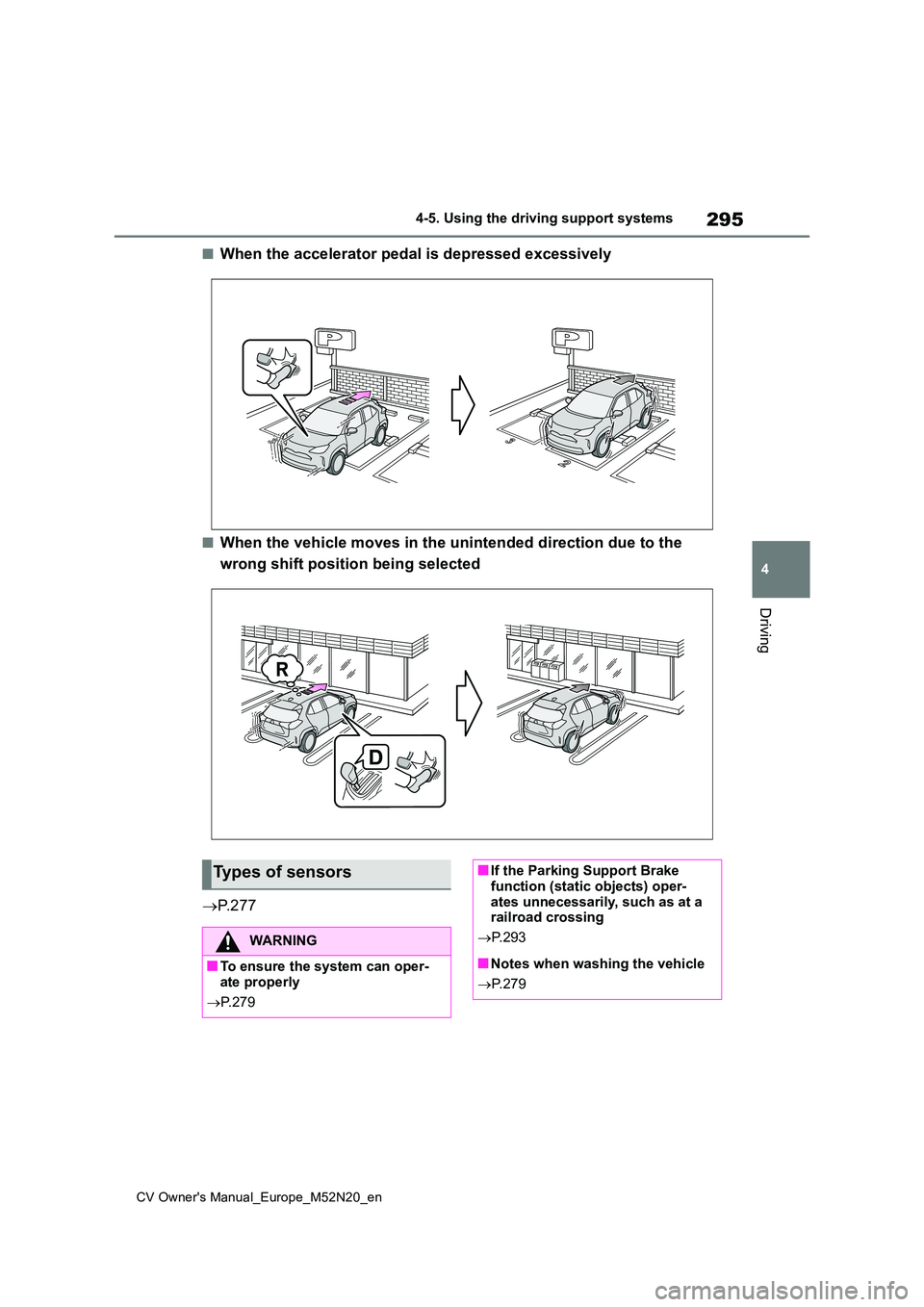
295
4
CV Owner's Manual_Europe_M52N20_en
4-5. Using the driving support systems
Driving
■When the accelerator pedal is depressed excessively
■When the vehicle moves in the unintended direction due to the
wrong shift position being selected
P. 2 7 7
Types of sensors
WARNING
■To ensure the system can oper- ate properly
P. 2 7 9
■If the Parking Support Brake function (static objects) oper-
ates unnecessarily, such as at a railroad crossing
P. 2 9 3
■Notes when washing the vehicle
P. 2 7 9
Page 298 of 618
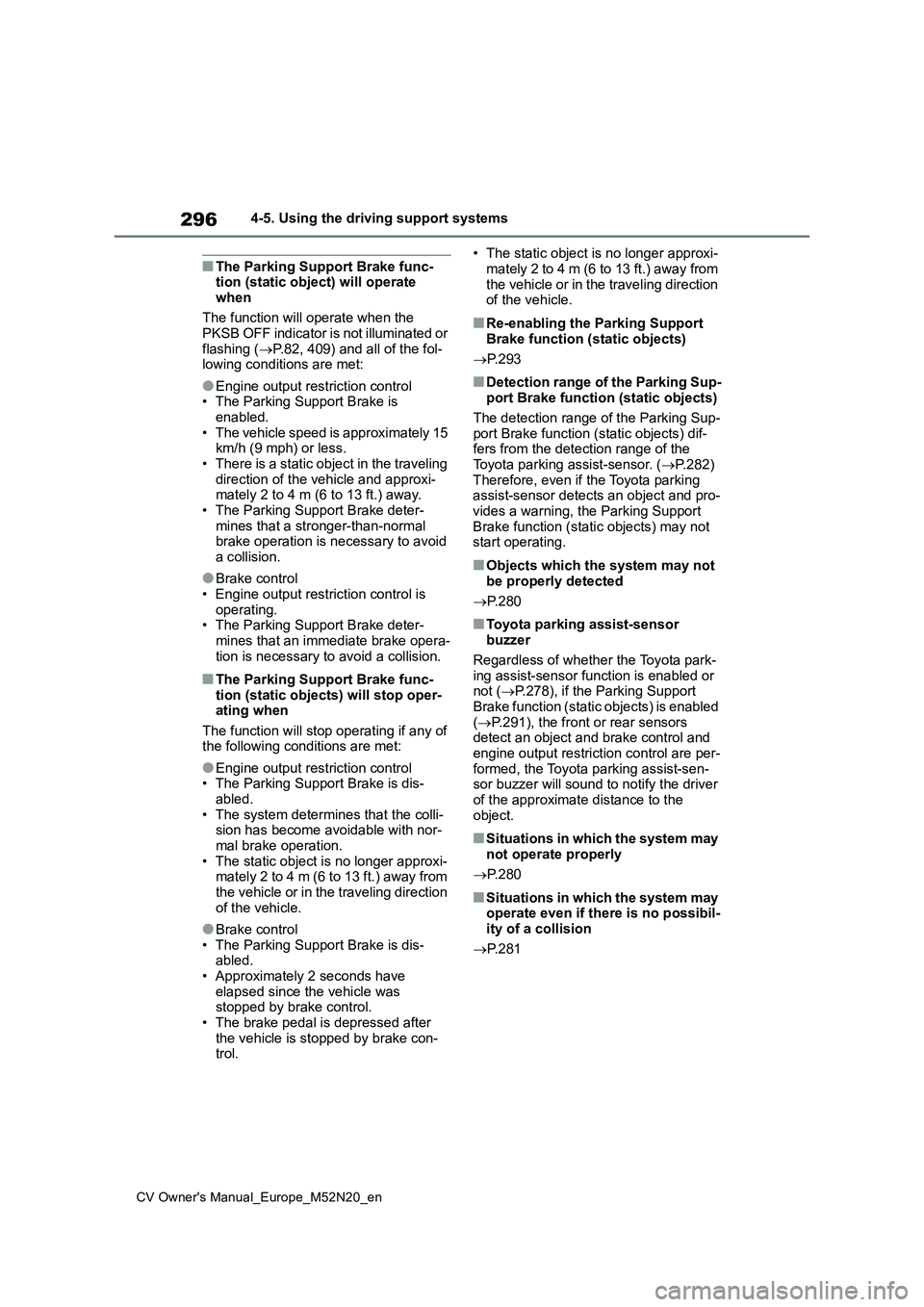
296
CV Owner's Manual_Europe_M52N20_en
4-5. Using the driving support systems
■The Parking Support Brake func- tion (static object) will operate
when
The function will operate when the PKSB OFF indicator is not illuminated or
flashing ( P.82, 409) and all of the fol- lowing conditions are met:
●Engine output restriction control• The Parking Support Brake is enabled.
• The vehicle speed is approximately 15 km/h (9 mph) or less.• There is a static object in the traveling
direction of the vehicle and approxi- mately 2 to 4 m (6 to 13 ft.) away.• The Parking Support Brake deter-
mines that a stronger-than-normal brake operation is necessary to avoid a collision.
●Brake control• Engine output restriction control is
operating. • The Parking Support Brake deter-mines that an immediate brake opera-
tion is necessary to avoid a collision.
■The Parking Support Brake func- tion (static objects) will stop oper-ating when
The function will stop operating if any of the following conditions are met:
●Engine output restriction control• The Parking Support Brake is dis-
abled. • The system determines that the colli-sion has become avoidable with nor-
mal brake operation. • The static object is no longer approxi-mately 2 to 4 m (6 to 13 ft.) away from
the vehicle or in the traveling direction of the vehicle.
●Brake control• The Parking Support Brake is dis-abled.
• Approximately 2 seconds have elapsed since the vehicle was stopped by brake control.
• The brake pedal is depressed after the vehicle is stopped by brake con-trol.
• The static object is no longer approxi-
mately 2 to 4 m (6 to 13 ft.) away from the vehicle or in the traveling direction of the vehicle.
■Re-enabling the Parking Support
Brake function (static objects)
P. 2 9 3
■Detection range of the Parking Sup- port Brake function (static objects)
The detection range of the Parking Sup- port Brake function (static objects) dif-fers from the detection range of the
Toyota parking assist-sensor. ( P.282) Therefore, even if the Toyota parking assist-sensor detects an object and pro-
vides a warning, the Parking Support Brake function (static objects) may not start operating.
■Objects which the system may not
be properly detected
P. 2 8 0
■Toyota parking assist-sensor buzzer
Regardless of whether the Toyota park- ing assist-sensor function is enabled or not ( P.278), if the Parking Support
Brake function (static objects) is enabled ( P.291), the front or rear sensors detect an object and brake control and
engine output restriction control are per- formed, the Toyota parking assist-sen-sor buzzer will sound to notify the driver
of the approximate distance to the object.
■Situations in which the system may not operate properly
P. 2 8 0
■Situations in which the system may operate even if there is no possibil-ity of a collision
P. 2 8 1
Page 299 of 618
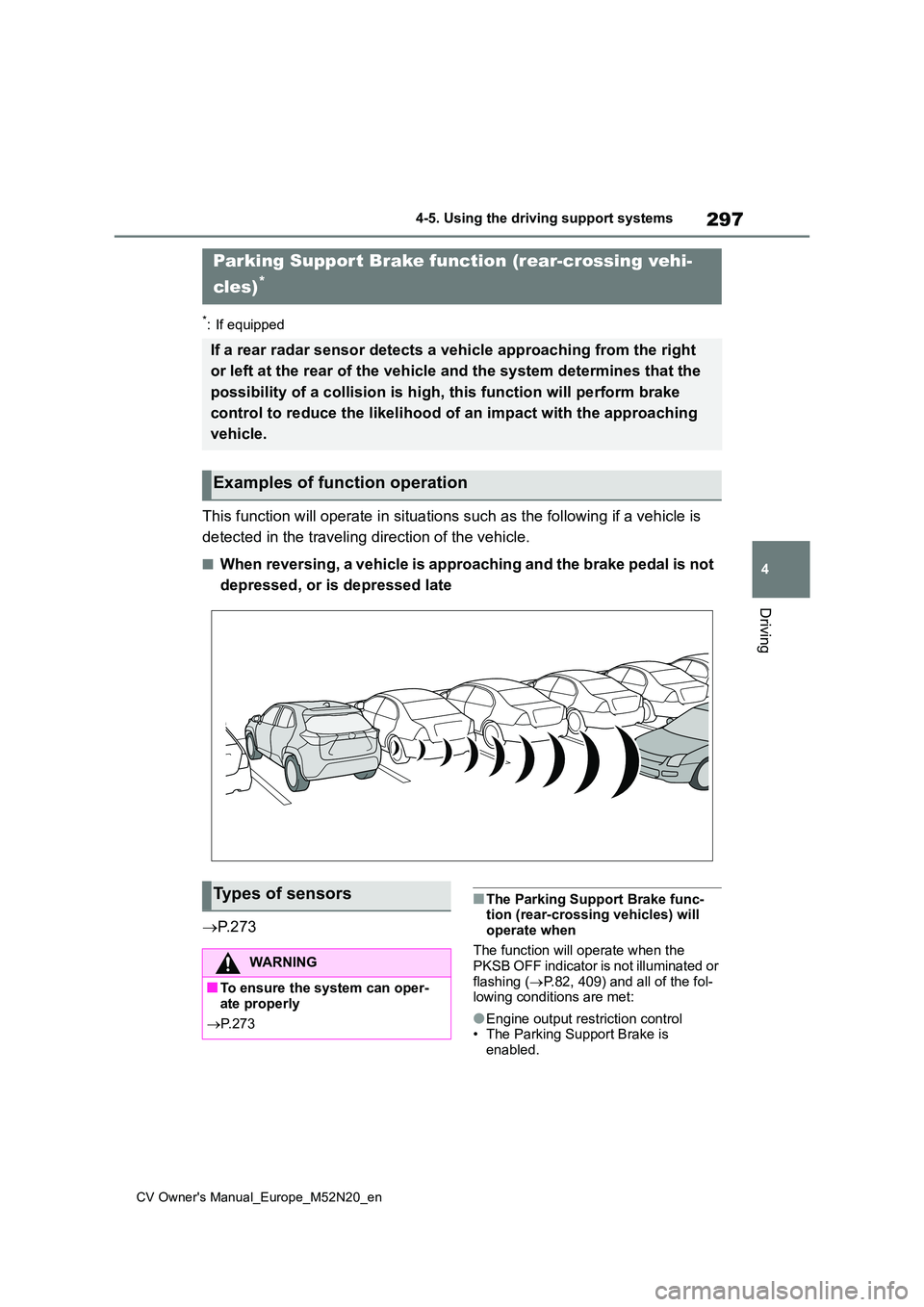
297
4
CV Owner's Manual_Europe_M52N20_en
4-5. Using the driving support systems
Driving
*: If equipped
This function will operate in situations such as the following if a vehicle is
detected in the traveling direction of the vehicle.
■When reversing, a vehicle is approaching and the brake pedal is not
depressed, or is depressed late
P. 2 7 3
■The Parking Support Brake func- tion (rear-crossing vehicles) will
operate when
The function will operate when the PKSB OFF indicator is not illuminated or
flashing ( P.82, 409) and all of the fol- lowing conditions are met:
●Engine output restriction control• The Parking Support Brake is enabled.
Parking Support Brake function (rear-crossing vehi-
cles)*
If a rear radar sensor detects a vehicle approaching from the r ight
or left at the rear of the vehicle and the system determines th at the
possibility of a collision is h igh, this function will perform brake
control to reduce the likelihood of an impact with the approach ing
vehicle.
Examples of function operation
Types of sensors
WARNING
■To ensure the system can oper- ate properly
P. 2 7 3
Page 303 of 618
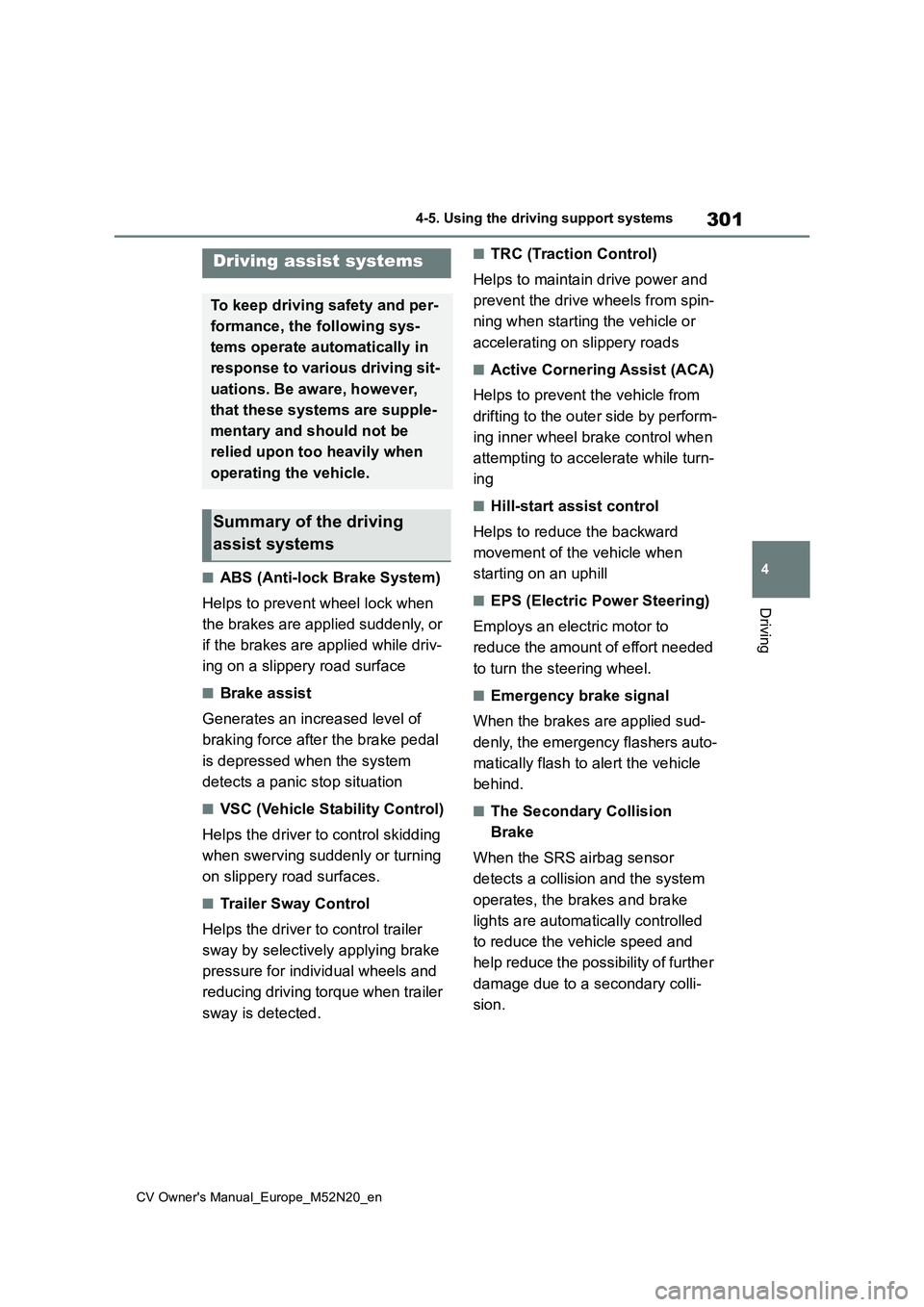
301
4
CV Owner's Manual_Europe_M52N20_en
4-5. Using the driving support systems
Driving
■ABS (Anti-lock Brake System)
Helps to prevent wheel lock when
the brakes are applied suddenly, or
if the brakes are applied while driv-
ing on a slippery road surface
■Brake assist
Generates an increased level of
braking force after the brake pedal
is depressed when the system
detects a panic stop situation
■VSC (Vehicle Stability Control)
Helps the driver to control skidding
when swerving suddenly or turning
on slippery road surfaces.
■Trailer Sway Control
Helps the driver to control trailer
sway by selectively applying brake
pressure for individual wheels and
reducing driving torque when trailer
sway is detected.
■TRC (Traction Control)
Helps to maintain drive power and
prevent the drive wheels from spin-
ning when starting the vehicle or
accelerating on slippery roads
■Active Cornering Assist (ACA)
Helps to prevent the vehicle from
drifting to the outer side by perform-
ing inner wheel brake control when
attempting to accelerate while turn-
ing
■Hill-start assist control
Helps to reduce the backward
movement of the vehicle when
starting on an uphill
■EPS (Electric Power Steering)
Employs an electric motor to
reduce the amount of effort needed
to turn the steering wheel.
■Emergency brake signal
When the brakes are applied sud-
denly, the emergency flashers auto-
matically flash to alert the vehicle
behind.
■The Secondary Collision
Brake
When the SRS airbag sensor
detects a collision and the system
operates, the brakes and brake
lights are automatically controlled
to reduce the vehicle speed and
help reduce the possibility of further
damage due to a secondary colli-
sion.
Driving assist systems
To keep driving safety and per-
formance, the f ollowing sys-
tems operate automatically in
response to various driving sit-
uations. Be aware, however,
that these systems are supple-
mentary and should not be
relied upon too heavily when
operating the vehicle.
Summary of the driving
assist systems
Page 306 of 618
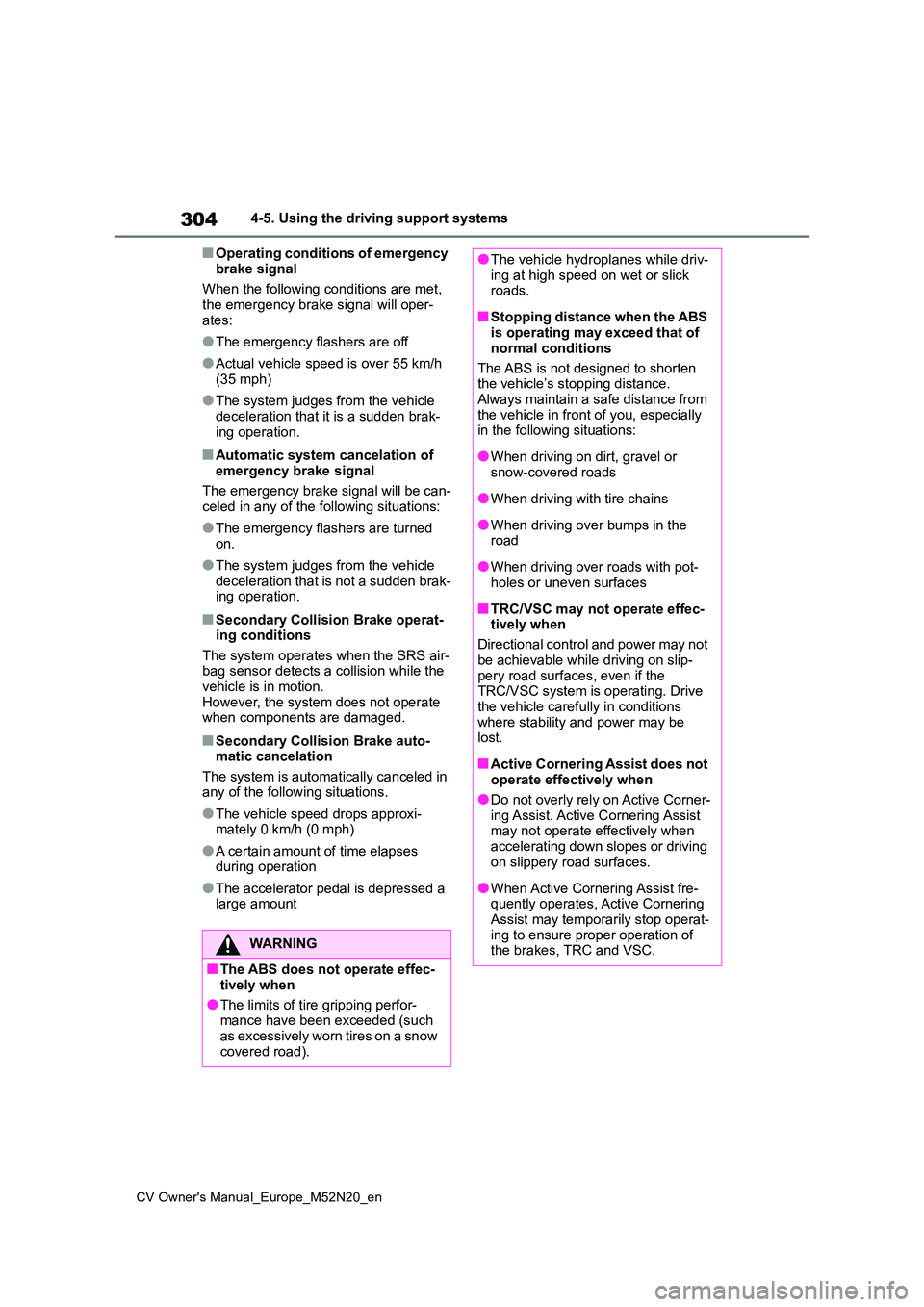
304
CV Owner's Manual_Europe_M52N20_en
4-5. Using the driving support systems
■Operating conditions of emergency
brake signal
When the following conditions are met, the emergency brake signal will oper-
ates:
●The emergency flashers are off
●Actual vehicle speed is over 55 km/h (35 mph)
●The system judges from the vehicle deceleration that it is a sudden brak-
ing operation.
■Automatic system cancelation of emergency brake signal
The emergency brake signal will be can-
celed in any of the following situations:
●The emergency flashers are turned
on.
●The system judges from the vehicle
deceleration that is not a sudden brak- ing operation.
■Secondary Collision Brake operat-ing conditions
The system operates when the SRS air- bag sensor detects a collision while the vehicle is in motion.
However, the system does not operate when components are damaged.
■Secondary Collision Brake auto-matic cancelation
The system is automatically canceled in any of the following situations.
●The vehicle speed drops approxi-mately 0 km/h (0 mph)
●A certain amount of time elapses during operation
●The accelerator pedal is depressed a large amount
WARNING
■The ABS does not operate effec-
tively when
●The limits of tire gripping perfor- mance have been exceeded (such
as excessively worn tires on a snow covered road).
●The vehicle hydroplanes while driv-ing at high speed on wet or slick roads.
■Stopping distance when the ABS is operating may exceed that of
normal conditions
The ABS is not designed to shorten the vehicle’s stopping distance.
Always maintain a safe distance from the vehicle in front of you, especially in the following situations:
●When driving on dirt, gravel or snow-covered roads
●When driving with tire chains
●When driving over bumps in the road
●When driving over roads with pot-holes or uneven surfaces
■TRC/VSC may not operate effec-tively when
Directional control and power may not
be achievable while driving on slip- pery road surfaces, even if the TRC/VSC system is operating. Drive
the vehicle carefully in conditions where stability and power may be lost.
■Active Cornering Assist does not operate effectively when
●Do not overly rely on Active Corner-ing Assist. Active Cornering Assist may not operate effectively when
accelerating down slopes or driving on slippery road surfaces.
●When Active Cornering Assist fre-quently operates, Active Cornering Assist may temporarily stop operat-
ing to ensure proper operation of the brakes, TRC and VSC.
Page 411 of 618
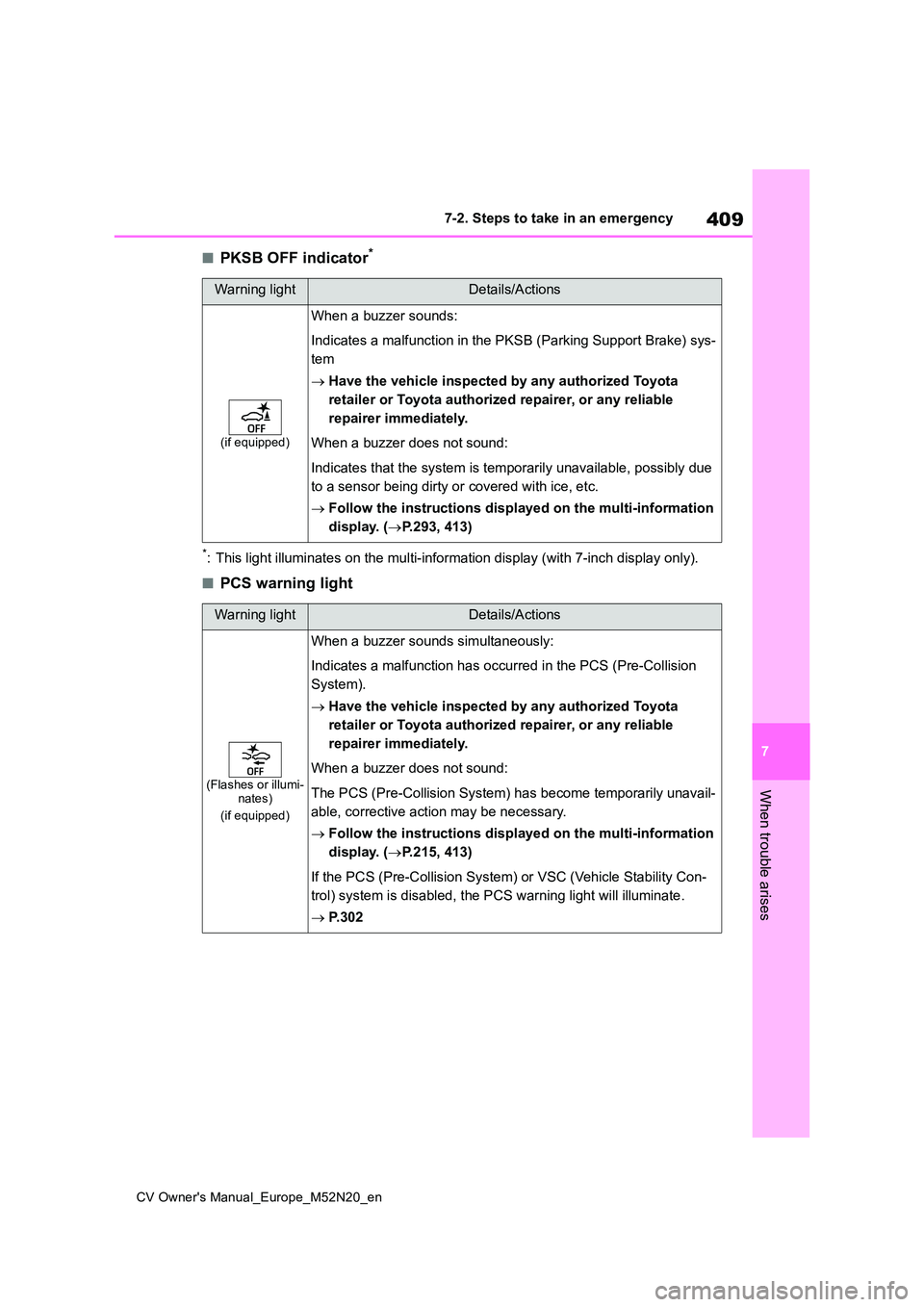
409
7
CV Owner's Manual_Europe_M52N20_en
7-2. Steps to take in an emergency
When trouble arises
■PKSB OFF indicator*
*: This light illuminates on the multi-information display (with 7-inch display only).
■PCS warning light
Warning lightDetails/Actions
(if equipped)
When a buzzer sounds:
Indicates a malfunction in the PKSB (Parking Support Brake) sys -
tem
Have the vehicle inspected by any authorized Toyota
retailer or Toyota authorized repairer, or any reliable
repairer immediately.
When a buzzer does not sound:
Indicates that the system is temporarily unavailable, possibly due
to a sensor being dirty or covered with ice, etc.
Follow the instructions displayed on the multi-information
display. ( P.293, 413)
Warning lightDetails/Actions
(Flashes or illumi- nates)
(if equipped)
When a buzzer sounds simultaneously:
Indicates a malfunction has occurred in the PCS (Pre-Collision
System).
Have the vehicle inspected by any authorized Toyota
retailer or Toyota authorized repairer, or any reliable
repairer immediately.
When a buzzer does not sound:
The PCS (Pre-Collision System) has become temporarily unavail-
able, corrective action may be necessary.
Follow the instructions displayed on the multi-information
display. ( P.215, 413)
If the PCS (Pre-Collision System) or VSC (Vehicle Stability Con-
trol) system is disabled, the PCS warning light will illuminate .
P. 3 0 2
Page 412 of 618
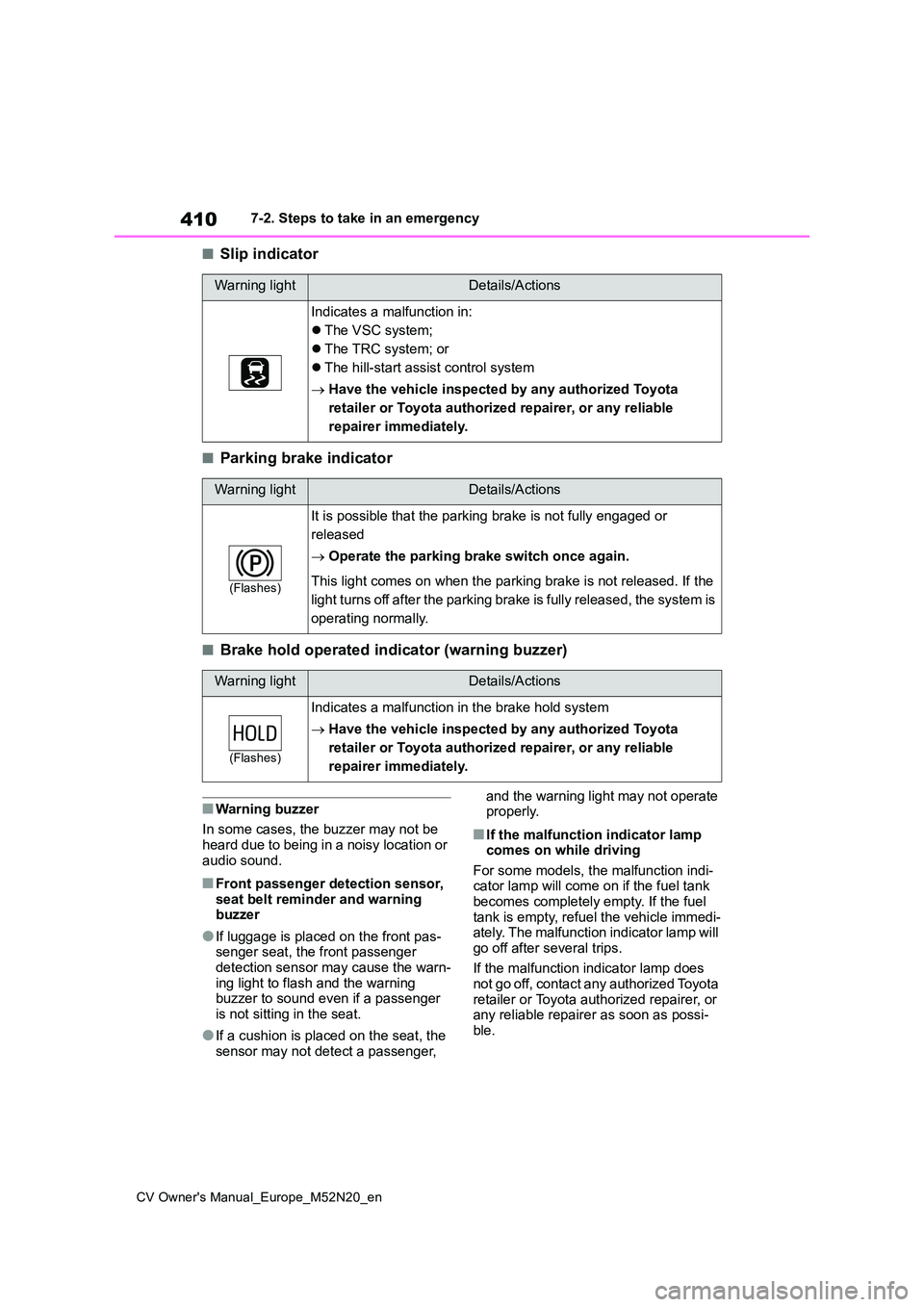
410
CV Owner's Manual_Europe_M52N20_en
7-2. Steps to take in an emergency
■Slip indicator
■Parking brake indicator
■Brake hold operated indicator (warning buzzer)
■Warning buzzer
In some cases, the buzzer may not be heard due to being in a noisy location or
audio sound.
■Front passenger detection sensor, seat belt reminder and warning buzzer
●If luggage is placed on the front pas-senger seat, the front passenger
detection sensor may cause the warn- ing light to flash and the warning buzzer to sound even if a passenger
is not sitting in the seat.
●If a cushion is placed on the seat, the
sensor may not detect a passenger,
and the warning light may not operate properly.
■If the malfunction indicator lamp comes on while driving
For some models, the malfunction indi- cator lamp will come on if the fuel tank becomes completely empty. If the fuel
tank is empty, refuel the vehicle immedi- ately. The malfunction indicator lamp will
go off after several trips.
If the malfunction indicator lamp does not go off, contact any authorized Toyota
retailer or Toyota authorized repairer, or any reliable repairer as soon as possi-ble.
Warning lightDetails/Actions
Indicates a malfunction in:
The VSC system;
The TRC system; or
The hill-start assist control system
Have the vehicle inspected by any authorized Toyota
retailer or Toyota authorized repairer, or any reliable
repairer immediately.
Warning lightDetails/Actions
(Flashes)
It is possible that the parking brake is not fully engaged or
released
Operate the parking brake switch once again.
This light comes on when the parking brake is not released. If the
light turns off after the parking brake is fully released, the system is
operating normally.
Warning lightDetails/Actions
(Flashes)
Indicates a malfunction in the brake hold system
Have the vehicle inspected by any authorized Toyota
retailer or Toyota authorized repairer, or any reliable
repairer immediately.
Page 436 of 618
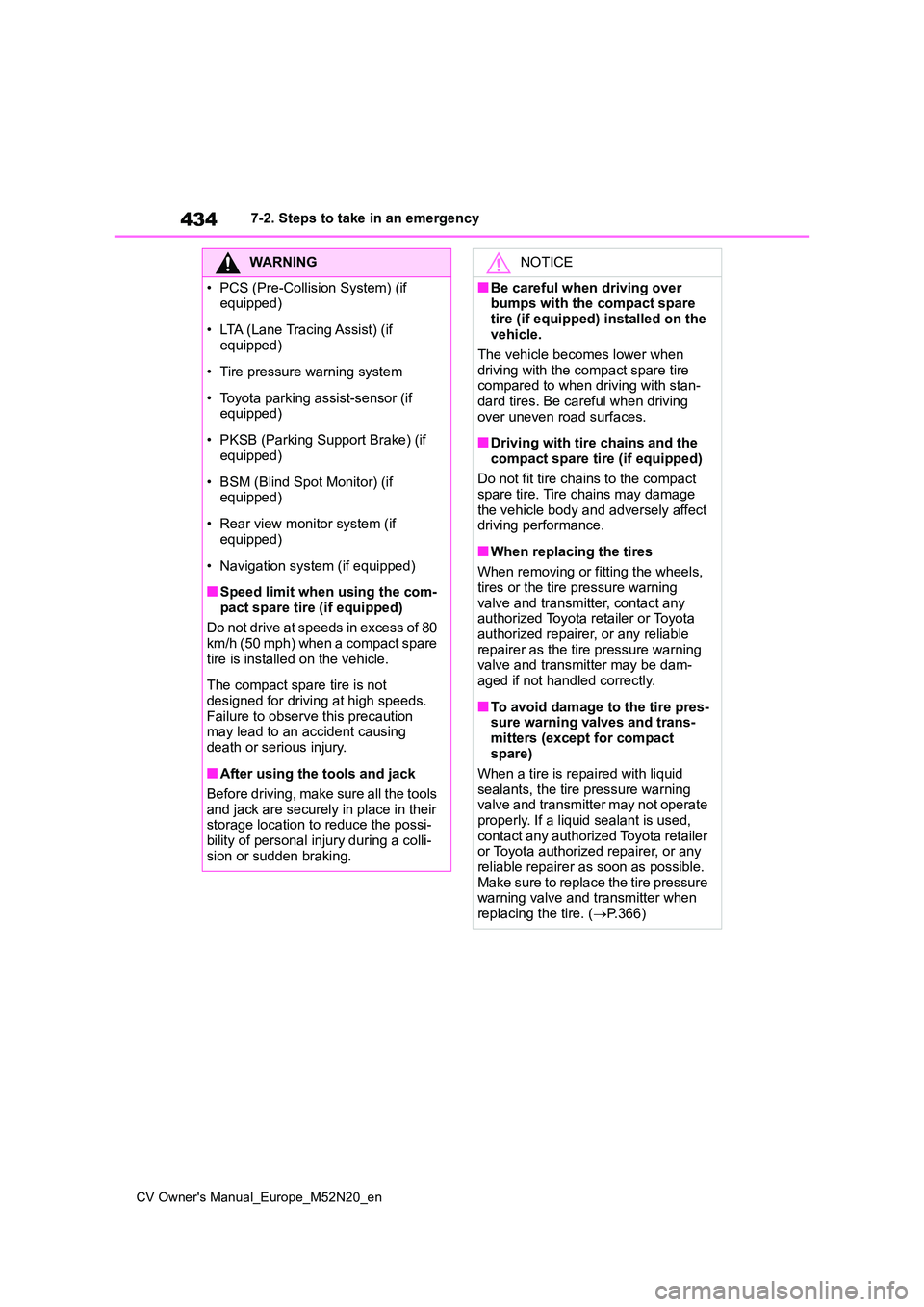
434
CV Owner's Manual_Europe_M52N20_en
7-2. Steps to take in an emergency
WARNING
• PCS (Pre-Collision System) (if equipped)
• LTA (Lane Tracing Assist) (if equipped)
• Tire pressure warning system
• Toyota parking assist-sensor (if equipped)
• PKSB (Parking Support Brake) (if equipped)
• BSM (Blind Spot Monitor) (if equipped)
• Rear view monitor system (if equipped)
• Navigation system (if equipped)
■Speed limit when using the com-
pact spare tire (if equipped)
Do not drive at speeds in excess of 80 km/h (50 mph) when a compact spare
tire is installed on the vehicle.
The compact spare tire is not
designed for driving at high speeds. Failure to observe this precaution may lead to an accident causing
death or serious injury.
■After using the tools and jack
Before driving, make sure all the tools and jack are securely in place in their storage location to reduce the possi-
bility of personal injury during a colli- sion or sudden braking.
NOTICE
■Be careful when driving over bumps with the compact spare
tire (if equipped) installed on the vehicle.
The vehicle becomes lower when
driving with the compact spare tire compared to when driving with stan-dard tires. Be careful when driving
over uneven road surfaces.
■Driving with tire chains and the
compact spare tire (if equipped)
Do not fit tire chains to the compact spare tire. Tire chains may damage
the vehicle body and adversely affect driving performance.
■When replacing the tires
When removing or fitting the wheels, tires or the tire pressure warning
valve and transmitter, contact any authorized Toyota retailer or Toyota authorized repairer, or any reliable
repairer as the tire pressure warning valve and transmitter may be dam-aged if not handled correctly.
■To avoid damage to the tire pres-sure warning valves and trans-
mitters (except for compact spare)
When a tire is repaired with liquid
sealants, the tire pressure warning valve and transmitter may not operate properly. If a liquid sealant is used,
contact any authorized Toyota retailer or Toyota authorized repairer, or any reliable repairer as soon as possible.
Make sure to replace the tire pressure warning valve and transmitter when replacing the tire. ( P.366)
Page 474 of 618
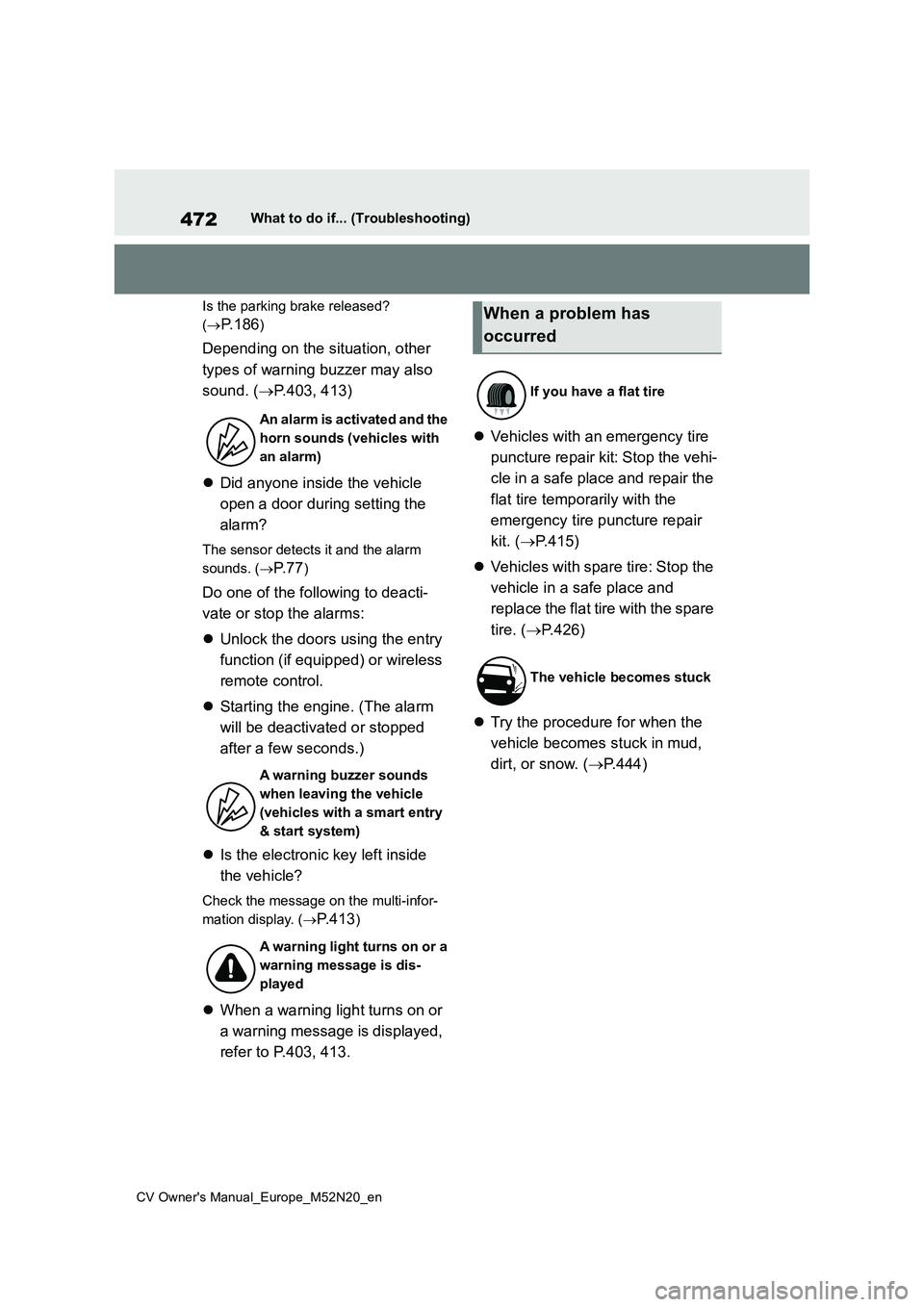
472
CV Owner's Manual_Europe_M52N20_en
What to do if... (Troubleshooting)
Is the parking brake released?
( P. 1 8 6)
Depending on the situation, other
types of warning buzzer may also
sound. ( P.403, 413)
Did anyone inside the vehicle
open a door during setting the
alarm?
The sensor detects it and the alarm
sounds. ( P. 7 7)
Do one of the following to deacti-
vate or stop the alarms:
Unlock the doors using the entry
function (if equipped) or wireless
remote control.
Starting the engine. (The alarm
will be deactivated or stopped
after a few seconds.)
Is the electronic key left inside
the vehicle?
Check the message on the multi-infor-
mation display. ( P.413)
When a warning light turns on or
a warning message is displayed,
refer to P.403, 413.
Vehicles with an emergency tire
puncture repair kit: Stop the vehi-
cle in a safe place and repair the
flat tire temporarily with the
emergency tire puncture repair
kit. ( P.415)
Vehicles with spare tire: Stop the
vehicle in a safe place and
replace the flat tire with the spare
tire. ( P.426)
Try the procedure for when the
vehicle becomes stuck in mud,
dirt, or snow. ( P.444)
An alarm is activated and the
horn sounds (vehicles with
an alarm)
A warning buzzer sounds
when leaving the vehicle
(vehicles with a smart entry
& start system)
A warning light turns on or a
warning message is dis-
played
When a problem has
occurred
If you have a flat tire
The vehicle becomes stuck
Page 476 of 618
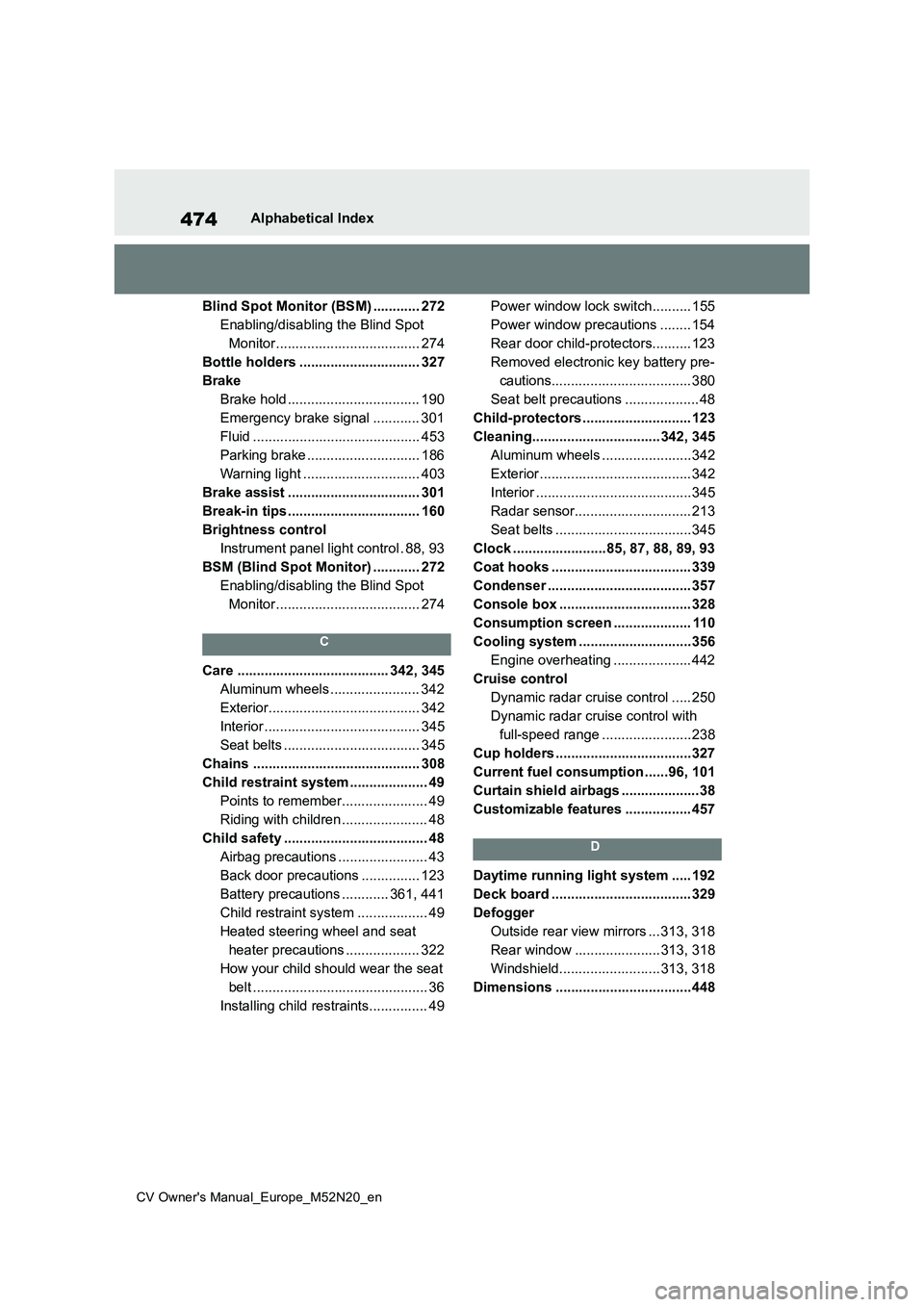
474
CV Owner's Manual_Europe_M52N20_en
Alphabetical Index
Blind Spot Monitor (BSM) ............ 272
Enabling/disabling the Blind Spot
Monitor..................................... 274
Bottle holders ............................... 327
Brake
Brake hold .................................. 190
Emergency brake signal ............ 301
Fluid ........................................... 453
Parking brake ............................. 186
Warning light .............................. 403
Brake assist .................................. 301
Break-in tips .................................. 160
Brightness control
Instrument panel light control . 88, 93
BSM (Blind Spot Monitor) ............ 272
Enabling/disabling the Blind Spot
Monitor..................................... 274
C
Care ....................................... 342, 345
Aluminum wheels ....................... 342
Exterior....................................... 342
Interior ........................................ 345
Seat belts ................................... 345
Chains ........................................... 308
Child restraint system .................... 49
Points to remember...................... 49
Riding with children ...................... 48
Child safety ..................................... 48
Airbag precautions ....................... 43
Back door precautions ............... 123
Battery precautions ............ 361, 441
Child restraint system .................. 49
Heated steering wheel and seat
heater precautions ................... 322
How your child should wear the seat
belt ............................................. 36
Installing child restraints............... 49
Power window lock switch.......... 155
Power window precautions ........ 154
Rear door child-protectors.......... 123
Removed electronic key battery pre-
cautions.................................... 380
Seat belt precautions ................... 48
Child-protectors ............................ 123
Cleaning................................. 342, 345
Aluminum wheels .......................342
Exterior ....................................... 342
Interior ........................................345
Radar sensor.............................. 213
Seat belts ...................................345
Clock ........................85, 87, 88, 89, 93
Coat hooks .................................... 339
Condenser ..................................... 357
Console box .................................. 328
Consumption screen .................... 110
Cooling system .............................356
Engine overheating .................... 442
Cruise control
Dynamic radar cruise control ..... 250
Dynamic radar cruise control with
full-speed range .......................238
Cup holders ...................................327
Current fuel consumption ......96, 101
Curtain shield airbags ....................38
Customizable features ................. 457
D
Daytime running light system ..... 192
Deck board .................................... 329
Defogger
Outside rear view mirrors ... 313, 318
Rear window ...................... 313, 318
Windshield.......................... 313, 318
Dimensions ...................................448